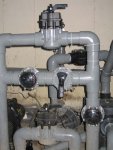I have a 2-speed pump for my system circulation and it is shares the spa jets (4 jets) with another spa-only pump circuit (other 6 jets). At lo-speed (50 GPM) I noticed considerable air bubbles coming from my pool return lines. This is the funny thing. It doesn't seem to do this at hi-speed (105 GPM). Perhaps the water surface is agitated too much to see it but I doubt it. However, when I turn OFF my spa spillway (I have 4 jets going to hot tub on a spillway back to the pool), the bubbles go away on lo-speed. On high speed it makes no difference since there were never bubbles there in the first place.
What sort of air leak would ONLY show itself at a lower pump flow and not high pump flow? I know the spillway is using the spa as a return which uses venturi effect to draw air into the spa jets, but how would this draw the air all the way back to the pool and only at lower flows?
What sort of air leak would ONLY show itself at a lower pump flow and not high pump flow? I know the spillway is using the spa as a return which uses venturi effect to draw air into the spa jets, but how would this draw the air all the way back to the pool and only at lower flows?



